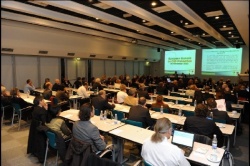2010 European Summit on CVD Prevention review
"Some progress, but the big challenges remain". This was the verdict after the European Society of Cardiology (ESC) hosted the 2010 European Summit on CVD Prevention on 30 November. The summit was attended by a broad cross-section of medical experts, healthcare organisations, national societies, regulators and representatives from the European Union (EU). The aim of this bi-annual event is to encourage concerted action towards a harmonised strategy for the prevention of cardiovascular disease (CVD) in Europe.


Much of the debate centred on how the EU and national governments should respond to overwhelming evidence that shows how lifestyle factors such as poor diet, lack of exercise, alcohol abuse and smoking have turned CVD into an epidemic that medical science alone cannot treat.
Professor Ian Graham, Professor of Cardiovascular Medicine at Trinity College, Dublin, organised the summit on behalf of the ESC’s European Association for Cardiovascular Prevention and Rehabilitation (EACPR). He accepts that the scale of political and regulatory change required is a massive challenge, but points to the stark reality of the situation. “It is shocking that the vast majority of the four million or so deaths in Europe each year from CVD can be attributed to lifestyle issues rather than underlying medical conditions. We are ready to support the EU and other public bodies in any way we can to take bold action.”
The ESC argues that complete alignment is needed between guidelines, clinical practice and public health policies before the problem can even begin to be addressed. This will inevitably mean that sensitive and difficult issues have to be debated and radical measures proposed, notes Professor Lars Rydén, a former President of ESC and a speaker at the summit. “There are no new medical techniques that can control the CVD epidemic,” he says. “The ESC has consistently presented data to governments and institutions to illustrate the urgency of the situation. We now look to the EU and other bodies to move beyond data, reports and abstract plans into a far-reaching legislative programme that ensures public health.”
Speakers at the summit included representatives of the EU and World Health Organization (WHO), who were invited to give their perspectives on how political actions could help deliver the social changes necessary to reduce the impact of CVD. Doctor Lars Møller of the WHO Regional Office for Europe recognises the pressure to move away from campaigns to a more policy-oriented approach. “Public awareness and education campaigns have not been successful,” he says. “The WHO is now in the process of drafting action plans on alcohol and on non-communicable diseases for implementing adopted strategies. Such plans give guidance to member states on evidence-based policy measures for decreasing the burden of CVD and other non-communicable diseases. This can include subsidies to favour healthy diet choices, increasing taxation, limiting availability of alcohol and tobacco, and promoting the benefits of exercise more widely.”
Cristian Busoi is a Member of the European Parliament (MEP) from Romania and an influential member of the MEP Heart Group. He is under no illusions of the seriousness of the CVD epidemic. In his address to the summit, he emphasised that action is needed in relation to the lifestyle factors that cause cardiovascular diseases, namely unhealthy diet, lack of exercise, tobacco consumption and alcohol abuse. He concluded, “We have seen that cardiovascular diseases are a serious threat to public health. There is evidence that urgent action is needed to prevent such diseases. It is time to do something more than just talking about it. The EU, as well as national authorities, needs to take concrete steps in this direction and promote healthy lifestyles through all the relevant policies in a coordinated manner, so that the measures have the utmost level of effectiveness.”
Around 90 people representing 45 organisations attended the summit, which was held at Heart House, the ESC headquarters in Sophia Antipolis. Delegates heard that excellent progress has been made by member countries of the ESC in adopting the European Heart Health Charter (EHHC) and in implementing the 4th JTF Guidelines, and were given an overview of best practice by speakers from UK, Italy and Bosnia-Herzegovina. The work in updating the guidelines for 2011 was also covered at the summit, with presentations on new techniques for assessing risk factors and a short review of lessons learnt.
All delegates are expected to sign-up to a set of principles agreed at the summit, while the Cardiac Societies of ESC member countries will be asked to commit to a series of actions to promote prevention. Summarising the outcome of the summit, Professor Graham said, “I was very pleased to see so many influential people at Heart House contributing to the discussions. We cannot allow the strong consensus we achieved to be ignored just because the political challenges of active prevention are difficult. The danger from silence on this issue is that CVD and other chronic diseases will continue to cause many unnecessary deaths while the cost of treatment will drain healthcare budgets.”
07.12.2010










